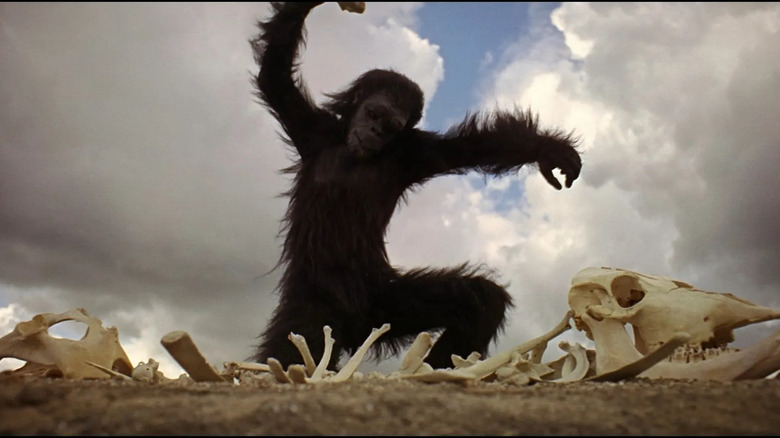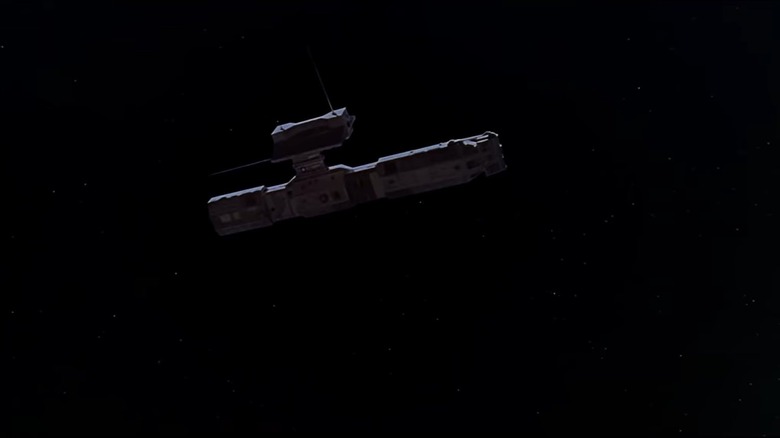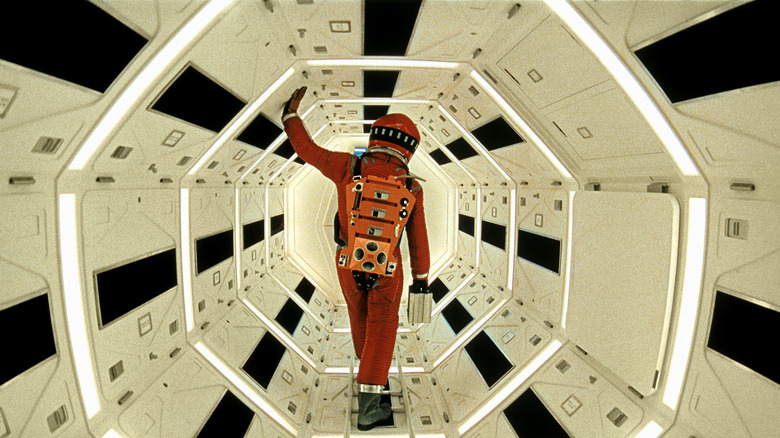This Was Keir Dullea's Favorite Sequence In 2001: A Space Odyssey
Stanley Kubrick's "2001: A Space Odyssey" is not only one of the greatest science-fiction films of all time (or is it science-fact?), it's one of the most varied. Beginning at "The Dawn of Man" and stretching all the way to "Beyond the Infinite," the film spans a number of locations, years, and stylistic approaches that range from playfully satirical to psychedelically surreal.
With so much to choose from, selecting a favorite sequence would be difficult for any fan of the film. Turns out it's not so tricky for one of the movie's stars, Keir Dullea. Playing Dr. David Bowman, one of the two astronauts sent on the Discovery mission to Jupiter to investigate the Tycho Magnetic Anomaly's transmission to the planet, Dullea got to be involved with not only the movie's famous HAL 9000 drama but the wild trip through the Stargate to a mysterious, surreal hotel room. However, the actor's favorite sequence in the movie is not one he participated in. In fact, it could be argued his chosen sequence doesn't have any people in it at all — or no Homo sapiens, that is.
The dawn of man — and destruction
According to a 2018 interview with the Boston Globe (the 50th anniversary of the film's release), Keir Dullea's favorite part is the "Dawn of Man" sequence. In the series of opening scenes, the film follows an ape who is unnamed on screen but called "Moon-Watcher" in co-writer Arthur C. Clarke's novel based on the movie. Played by professional mime Daniel Richter with a costume designed by makeup artist Stuart Freeborn, Moon-Watcher finds his tribe challenged by a rival one over a patch of land containing fresh water — until he discovers a way to drive the challengers away.
Dullea considers Moon-Watcher's discovery of using a dead animal's bone as a weapon as one of "two great moments" in the sequence. The actor admires the way that "in one of [Moon-Watcher's] motions, a chip flies off in a very purposeful way," believing that to him, "that is the moment in history when the penny dropped in humankind, where the animal became a more modern entity." Certainly, Dullea was influenced by the powerful use of the recording of Richard Strauss' "Also Sprach Zarathustra" during the scene, not to mention editor Ray Lovejoy's juxtaposition of Moon-Watcher's bone strikes with the sight of animals falling down, as if in response.
The second great moment, according to Dullea, is one he considers "the greatest jump cut in history." After defeating the rival tribe, Moon-Watcher and his tribe celebrate, and he throws his bone into the air. As the camera follows the falling object, in a single cut the bone "morphs into a space vehicle," in Dullea's words, floating around Earth in 2001.
Yet the orbiting craft is "not just a space vehicle," as the actor points out. It's a nuclear weapon, essentially an orbiting destructive device. As such, Dullea sees Clarke's intention and Kubrick and Lovejoy's ingenious way of communicating that without dialogue, noting how the edit shows "the first weapon invented by the apes morphing into the most recent weapon."
Dullea praises '2001' as 'a visual symphony'
Stanley Kubrick's choice of stuffing "2001: A Space Odyssey" with preexisting works of classical music was just one of many deliberate choices by the meticulous director, made so as to emphasize the musical quality of the film over any concrete narrative. The "Dawn of Man" sequence is a great example of this approach, letting the music, sound effects, performances based in body language, and cinematography tell the story instead of any narration or dialogue.
When asked to interpret the film and its ending, Keir Dullea followed his director's lead, stating that "one of the best answers, which Stanley gave and I've always liked [is] ... how do you describe Beethoven's Fifth Symphony in words?" With music and "2001," both mean different things to different people.
For Dullea, this is one of the lasting qualities about the film he enjoys the most. He appreciates the way "every generation brings its persona to the experience, just as every individual does." The actor sees "2001" as "a visual symphony" with "many possibilities," a movie that brings so much to so many. In this way, it's easy to see "2001" as one of the Monoliths itself — a mysterious and inscrutable work that allows for infinite interpretations and continues to influence humanity in new and interesting ways. For Dullea, for human beings, and for the movie itself, it all starts with "The Dawn of Man."


